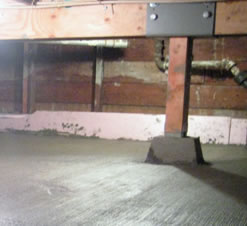The concrete floor

In this design a concrete pad called a “mud pad” is poured on the crawl space floor. This is essentially a concrete barrier meant to help control moisture in the crawl space. This is done several ways; with and with out a vapor barrier. The traditional mud pad is a poured concrete pad over a roughly graded dirt floor. There is little prep work done to flatten the area so the concrete thickness can range from 2” to 6” thick. The final grade of the concrete will appear flat.
A good contractor will install a vapor barrier on the floor prior to pouring the mud pad. This is done because the concrete itself is not a good moisture barrier. Water and moisture will pass through a concrete slab that does not have a vapor barrier with little trouble. The reason this is important is because if a vapor barrier was not used then closing the vents will cause other issues unless a dehumidifier is used. But if a barrier was used, then you will have more options on how to best control the humidity. Closing the vents is the key to fixing the cold crawl space problem.
The crawl space insulation installed in this application would be R-19. Install the insulation above the foundation wall inside the rim (or band) joist cavity only. Think of this design as a mini basement. Next time you are in a full size unfinished basement take a look up and you will see there is no insulation in the joist cavities. The most recent building code (IRC 2006) states that the insulation in the floor joist cavity is no longer needed if the exterior foundation walls are insulated. One option is to have (closed cell) spray foam installed on the foundation walls.
The real benefit here is to cover the portion of the foundation that is above the outside grade. The cost of this insulation is usually by the square foot, so the more you have sprayed on the more it will cost. Do not have the rim joist sprayed with this type of insulation. You could end up with problems repairing or replacing any wood that may get damaged due to insects or water damage. It also does not allow for termite inspection and that could be a huge issue if you plan to sell your home in the future. It would be a wise move to add a few heat ducts to the crawl space to keep it warm.
A few words of caution, although this design is far superior to the open crawl space it potentially has some of its own problems. Even with a vapor barrier under the mud pad you will have to find a way to control the moisture that comes in the crawl space from the unprotected foundation walls. This area has the same potential for moisture and water problems as a mud pad that does not have a vapor barrier. If you close the vents in this design you will have to install a dehumidifier to control excess moisture.
Photo Source-http://chezerbey.com/2012/01/0...